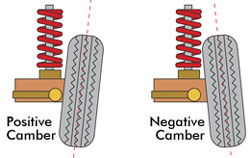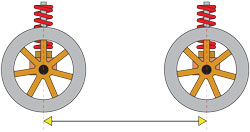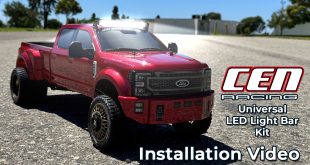
What is Camber?
Camber is the angle of the tops of the wheels from straight up and down. Leaning in is Negative Camber, leaning out is Positive Camber.
As a general rule, giving one end of the car less Camber gives that end less traction. For instance, if your car is loose (oversteer), you could either add a degree of rear Camber (recommended) or take out a degree of front Camber.
Oddly enough, Camber works a little differently on either end of a touring car. On the front, you should use roughly around -1 to -2deg of Camber due to the front wheels being power driven. Also, there is a point where you can add TOO much front Camber. If so, steering will decrease as the tires roll OVER the perfect contact patch area.
On the rear, Camber affects two things. In a straight line, maximum acceleration is achieved with 0° of Camber. Adding Camber reduces forward traction slightly, but you will gain cornering grip. So, there is a fine line on rear Camber.
See also: Roll Center
Tuning with Camber – Front
Less Camber
• More straight-line acceleration
• Less steering
• Easier to drive
More Camber
• Less forward traction
• More high-speed traction through corners
• More aggressive steering
• Less stable on the straight
Tuning with Camber – Rear
Less Camber
• More straight-line acceleration
• Less traction in the corners
• Less stable
More Camber
• Less forward traction
• More high-speed traction through corners
• Less stable on the straight
Back to the RC Suspension Tuning Guide.
 CompetitionX CompetitionX is the most up-to-date source for RC Car News, Reviews and Videos for Radio Control. We also have the most comprehensive Manual Database on the web.
CompetitionX CompetitionX is the most up-to-date source for RC Car News, Reviews and Videos for Radio Control. We also have the most comprehensive Manual Database on the web.

